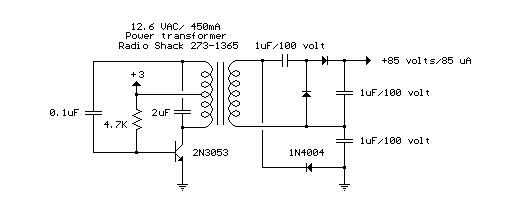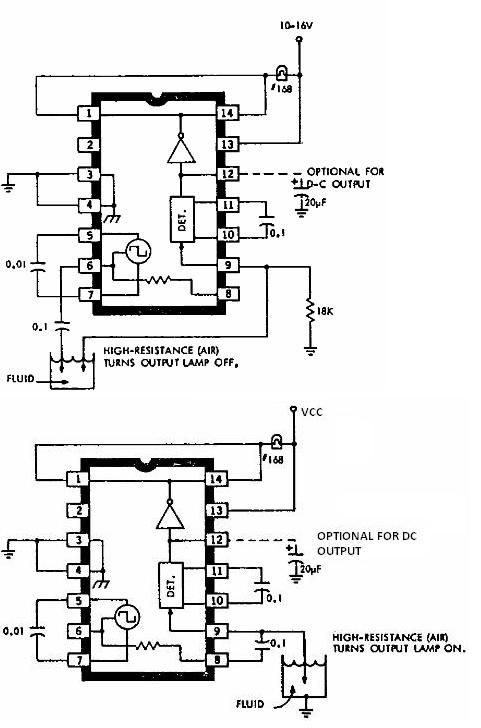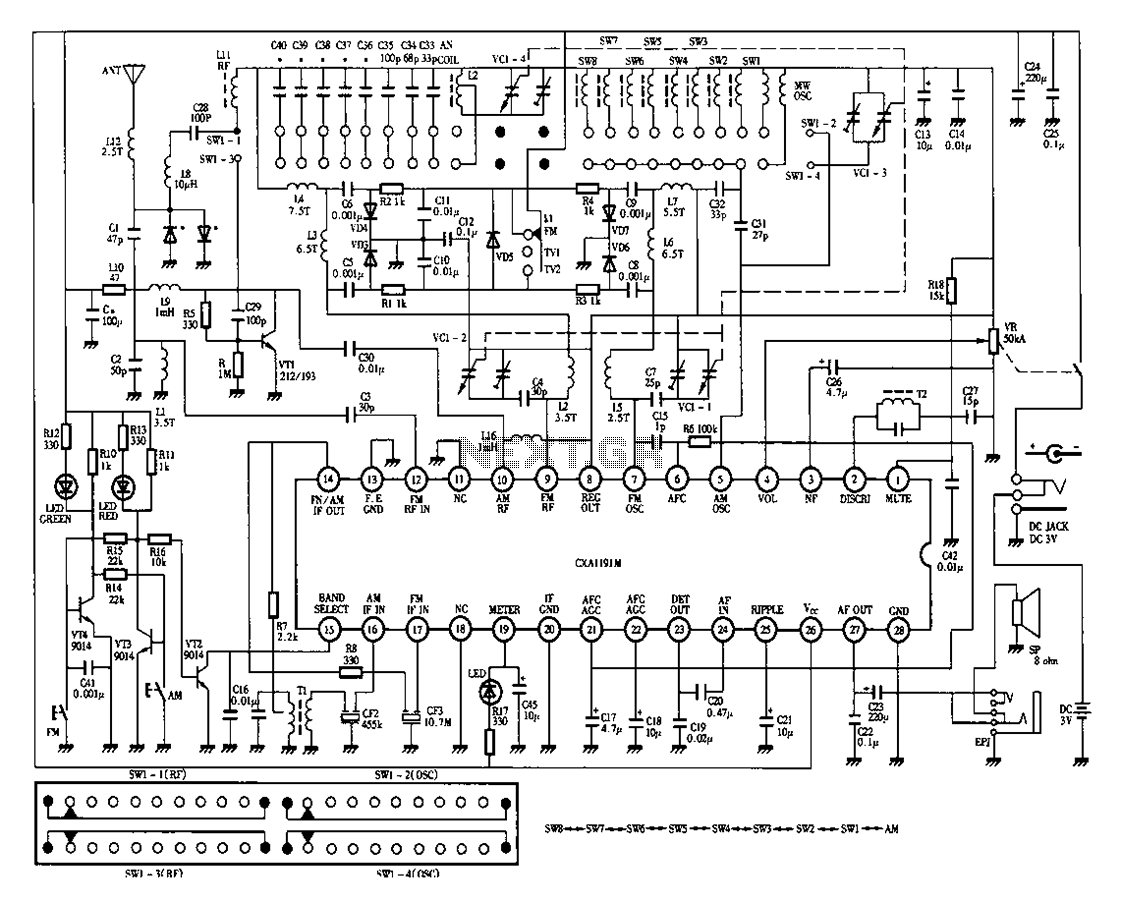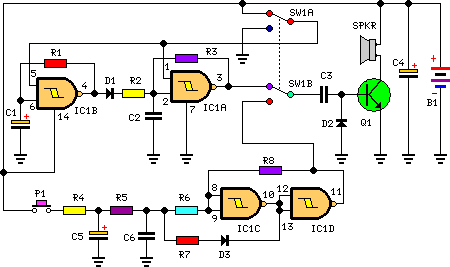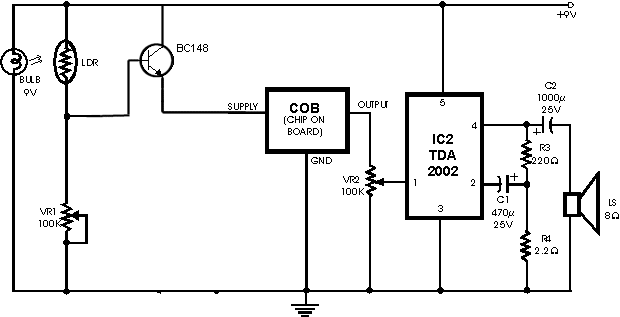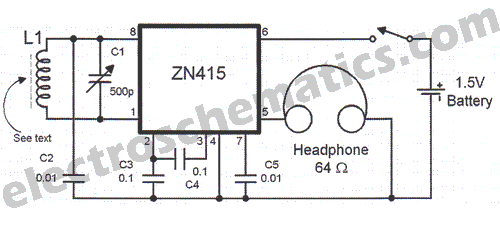
IR Headset Circuit with headphone Transmitter and Receiver diagram
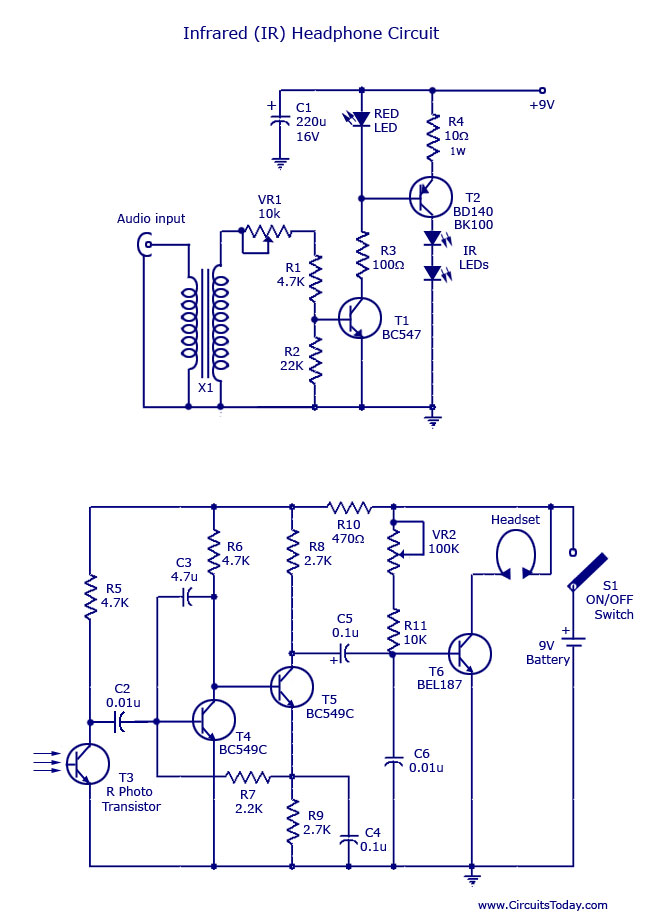
This document outlines a simple infrared (IR) headphone circuit designed for listening to television or radio without disturbing others. The IR headset is a preferable option for beginners compared to FM headsets due to its desirable sound quality that does not require tuning or complex impedance matching often found in radio circuits. The audio signal is coupled to the base of transistor T1 (BC547) via an audio transformer, which serves to pre-amplify the signal. Transistor T2 (BD140) drives the IR LEDs that transmit sound as infrared beams. A red LED provides fixed bias for T2 and serves as a power-on indicator. The transmitter operates effectively within a range of 5 meters under normal conditions and is powered by a 9V battery. The photo transistor T3 receives the infrared signals, with its collector connected to the base of transistor T4 (BC548), which amplifies the signal along with T5 (BC549) to recover the transmitted audio signal. Finally, transistor T6 drives the headphones to reproduce the sound. The receiver can also be powered by a 9V battery. The audio transformer can be sourced from an old transistor radio and should be connected to the audio input (TV or radio) using the low impedance winding (the thicker wire).
The infrared headphone circuit operates by converting audio signals into infrared light, which can be transmitted wirelessly to headphones. The circuit consists of two main sections: the transmitter and the receiver.
In the transmitter section, the audio signal from a TV or radio is fed into an audio transformer. This transformer is crucial as it matches the impedance of the audio source to the input of the circuit, ensuring optimal signal transfer. The pre-amplification stage uses the BC547 transistor (T1) to boost the audio signal strength before it is sent to the modulation stage.
The BD140 transistor (T2) functions as a modulator that drives multiple IR LEDs. These LEDs convert the modulated electrical audio signals into infrared light, which can be received by the headphones. The red LED not only indicates that the circuit is powered but also ensures that T2 operates within its optimal range. Powering the transmitter with a 9V battery allows for portability and ease of use, making it suitable for home entertainment systems.
The receiver section utilizes a photo transistor (T3) to detect the incoming infrared signals. The collector of T3 is connected to the base of the BC548 transistor (T4), which amplifies the detected signal. This amplified signal is further processed by the BC549 transistor (T5) to ensure that the audio output is clear and at an appropriate volume level.
Finally, the BC549 transistor (T6) drives the headphones, allowing users to hear the transmitted audio. The receiver is also powered by a 9V battery, ensuring that both the transmitter and receiver operate independently without the need for extensive wiring.
Overall, this IR headphone circuit is an effective solution for private listening, providing a simple and efficient way for users to enjoy audio without disturbing others in their vicinity. The use of common components and straightforward design principles makes it accessible for beginners in electronics.Here is a simple IR headphone circuit that is suitable for listening to TV or radio with out disturbing others. For beginners the IR headset is a better option than FM head sets because they often produce desirable sound quality with out tuning as well as difficult impedance matching that is often done in radio circuits which is difficult for begi
nners. The audio signal is coupled to the base of T1 (BC547) by an audio transformer. The T1 pre amplifies the signal. The transistor T2 (BD 140) drives the IR LED`s which transmit the sound as IR beams. The red LED provides fixed bias for theT2 as well as a power on indication. The transmitter has a 5m range under normal conditions. A 9V battery can be used to power the transmitter. The photo transistor T3 receives the IR signals. The collector of IR is connected to base of T4(BC548) which amplifies the signal together with T5 (BC549)to regain the audio signal transmitted. The transistor T6 drives the headphone to reproduce the sound. The receiver can be powered by using a 9V battery. The audio transformer can be easily obtained from a old transistor radio. It should be connected with the low impedance winding (thicker) to the audio input (TV or radio) side.
🔗 External reference
The infrared headphone circuit operates by converting audio signals into infrared light, which can be transmitted wirelessly to headphones. The circuit consists of two main sections: the transmitter and the receiver.
In the transmitter section, the audio signal from a TV or radio is fed into an audio transformer. This transformer is crucial as it matches the impedance of the audio source to the input of the circuit, ensuring optimal signal transfer. The pre-amplification stage uses the BC547 transistor (T1) to boost the audio signal strength before it is sent to the modulation stage.
The BD140 transistor (T2) functions as a modulator that drives multiple IR LEDs. These LEDs convert the modulated electrical audio signals into infrared light, which can be received by the headphones. The red LED not only indicates that the circuit is powered but also ensures that T2 operates within its optimal range. Powering the transmitter with a 9V battery allows for portability and ease of use, making it suitable for home entertainment systems.
The receiver section utilizes a photo transistor (T3) to detect the incoming infrared signals. The collector of T3 is connected to the base of the BC548 transistor (T4), which amplifies the detected signal. This amplified signal is further processed by the BC549 transistor (T5) to ensure that the audio output is clear and at an appropriate volume level.
Finally, the BC549 transistor (T6) drives the headphones, allowing users to hear the transmitted audio. The receiver is also powered by a 9V battery, ensuring that both the transmitter and receiver operate independently without the need for extensive wiring.
Overall, this IR headphone circuit is an effective solution for private listening, providing a simple and efficient way for users to enjoy audio without disturbing others in their vicinity. The use of common components and straightforward design principles makes it accessible for beginners in electronics.Here is a simple IR headphone circuit that is suitable for listening to TV or radio with out disturbing others. For beginners the IR headset is a better option than FM head sets because they often produce desirable sound quality with out tuning as well as difficult impedance matching that is often done in radio circuits which is difficult for begi
nners. The audio signal is coupled to the base of T1 (BC547) by an audio transformer. The T1 pre amplifies the signal. The transistor T2 (BD 140) drives the IR LED`s which transmit the sound as IR beams. The red LED provides fixed bias for theT2 as well as a power on indication. The transmitter has a 5m range under normal conditions. A 9V battery can be used to power the transmitter. The photo transistor T3 receives the IR signals. The collector of IR is connected to base of T4(BC548) which amplifies the signal together with T5 (BC549)to regain the audio signal transmitted. The transistor T6 drives the headphone to reproduce the sound. The receiver can be powered by using a 9V battery. The audio transformer can be easily obtained from a old transistor radio. It should be connected with the low impedance winding (thicker) to the audio input (TV or radio) side.
🔗 External reference
